The 2×2 Rubik’s Cube, also known as the Mini Cube or Pocket Cube, is a smaller, simpler version of the classic 3×3 Rubik’s Cube. It consists of 8 corner pieces with no edge or center pieces, making it an excellent starting point for beginners. This guide provides a step-by-step approach to solving the 2×2 cube, focusing on basic notation, solving strategies, and common cases. Perfect for those new to cubing, it offers an accessible way to build problem-solving skills and hand-eye coordination. Download the PDF guide to start your cubing journey today!
1.1 Overview of the 2×2 Rubik’s Cube
The 2×2 Rubik’s Cube, also known as the Pocket Cube, is a compact and straightforward puzzle consisting of 8 corner pieces with no edge or center pieces. Unlike the 3×3 version, the 2×2 cube has only two layers per face, making it simpler to solve. Each corner piece has three visible stickers, and the goal is to align these stickers so that each face displays a single solid color. The cube’s design allows for quick solutions, with most cases resolvable in just a few moves. Its simplicity makes it an ideal starting point for beginners, offering a gentle introduction to cubing concepts and algorithms. This guide provides a detailed approach to mastering the 2×2 cube efficiently.
1.2 Importance of a PDF Guide for Beginners
A PDF guide is an invaluable resource for beginners learning to solve the 2×2 Rubik’s Cube. It provides a structured, easy-to-follow format that breaks down the solving process into manageable steps. With detailed algorithms, visual aids, and clear instructions, a PDF guide ensures that learners can understand and master each stage without confusion. Its portability allows users to practice anywhere, making it a convenient tool for consistent learning. Additionally, a PDF guide offers a comprehensive overview of common cases and solutions, helping novices overcome challenges and build confidence in their problem-solving skills. This accessible format is perfect for those seeking a straightforward, self-paced learning experience.
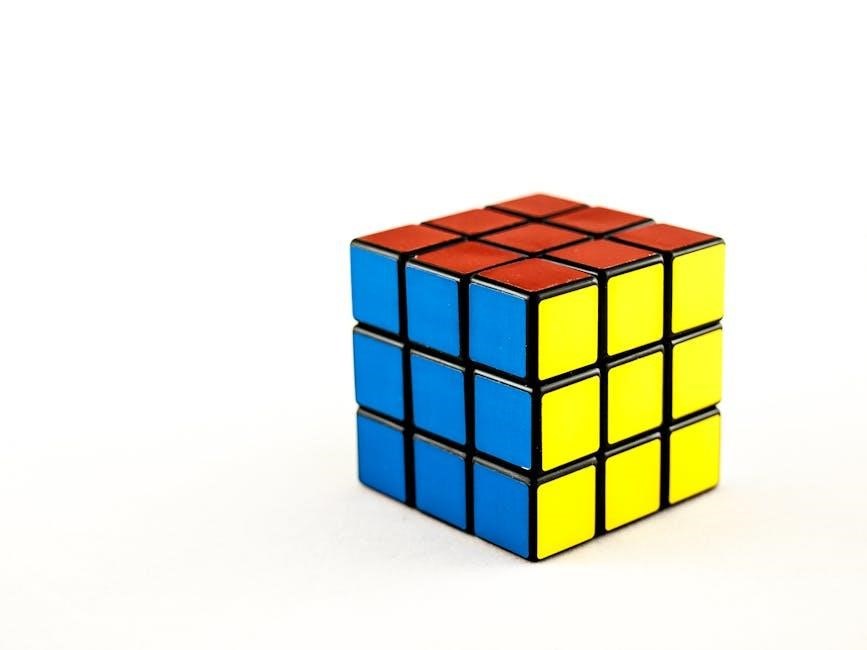
Understanding the Structure of the 2×2 Cube
The 2×2 Rubik’s Cube consists of two layers, each with four corner pieces and no edge pieces; Its simplicity makes it easier to solve than larger cubes.
2.1 Components of the 2×2 Rubik’s Cube
The 2×2 Rubik’s Cube, or Pocket Cube, is a compact puzzle consisting of two layers, each with four corner pieces. Unlike the 3×3 version, it has no edge pieces or center pieces, simplifying its structure. Each corner piece is a smaller cube with three visible faces, colored to match the overall design. The absence of fixed center pieces means there are no reference points, making it slightly more challenging to orient the cube during solving. Despite its simplicity, the 2×2 cube requires a strategic approach to align the corners correctly. Its compact size and fewer components make it an excellent starting point for beginners learning cube-solving techniques before moving to more complex puzzles.
2.2 Differences from the 3×3 Rubik’s Cube
The 2×2 Rubik’s Cube differs significantly from its 3×3 counterpart, primarily in structure and complexity. Unlike the 3×3, the 2×2 has no fixed center pieces, making it harder to orient the cube during solving. It consists of only 8 corner pieces, with no edge pieces, simplifying its mechanism. The 3×3 cube has 26 pieces, including corners, edges, and centers, offering more layers and solving possibilities. The 2×2 cube is smaller and lighter, with fewer algorithms required for solving, making it more accessible for beginners. However, the lack of center pieces means solvers must rely entirely on corner orientation and alignment, adding a unique challenge. This simplicity and reduced complexity make the 2×2 a great introduction to cubing before advancing to larger puzzles.
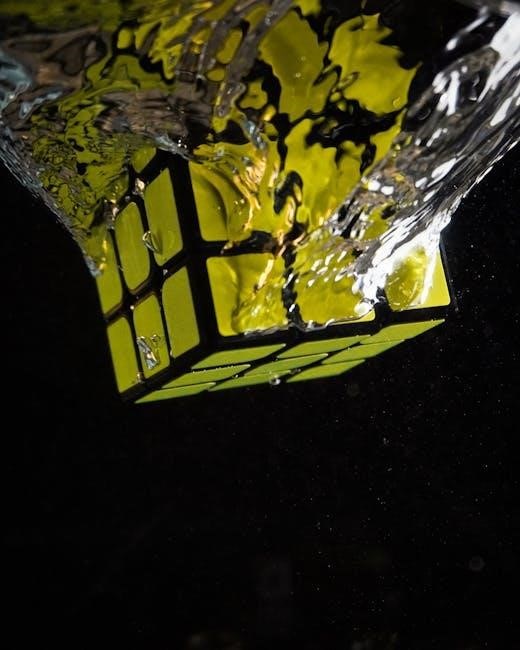
Basic Notation and Terminology
Understanding basic notation is crucial for solving the 2×2 Rubik’s Cube. Terms like “moves” and “rotations” refer to turning cube faces. The cube has three axes (x, y, z), with rotations like clockwise (CW) and counter-clockwise (CCW) defining movements. Common algorithms are used to solve specific cases. Notation helps in following step-by-step guides, ensuring clarity in solving strategies. This section will cover essential terms and symbols needed to master the 2×2 cube.
3.1 Understanding Cube Notation
Cube notation is a standardized way to describe moves on the Rubik’s Cube. The 2×2 cube uses a system where each face is identified by a letter: F (front), B (back), U (up), D (down), L (left), and R (right). A single letter indicates a clockwise rotation of that face, while an apostrophe (‘) denotes a counter-clockwise rotation. For example, “F” means turning the front face clockwise, and “F'” means turning it counter-clockwise. The notation also includes axes: x, y, and z, which represent rotations around the cube as a whole. Understanding this notation is essential for following algorithms and solving the cube efficiently. It provides a universal language for cubers to communicate moves clearly and precisely.
3.2 Key Terms for Solving the 2×2 Cube
Understanding key terms is crucial for mastering the 2×2 Rubik’s Cube. A “corner” refers to the small pieces with three visible faces, while a “layer” is a face and its adjacent pieces. The “axis” defines the cube’s rotation: x (right-left), y (top-bottom), and z (front-back). “Algorithms” are sequences of moves used to solve specific cases, such as orienting or permuting corners. Terms like “PLL” (Permuting Last Layer) and “CLL” (Corners of the Last Layer) describe advanced methods for finalizing the solve. “Orientation” refers to aligning colors correctly, while “permutation” involves placing pieces in their correct positions. Familiarizing yourself with these terms will help you follow tutorials and algorithms effectively, ensuring a smooth learning process for the 2×2 cube.
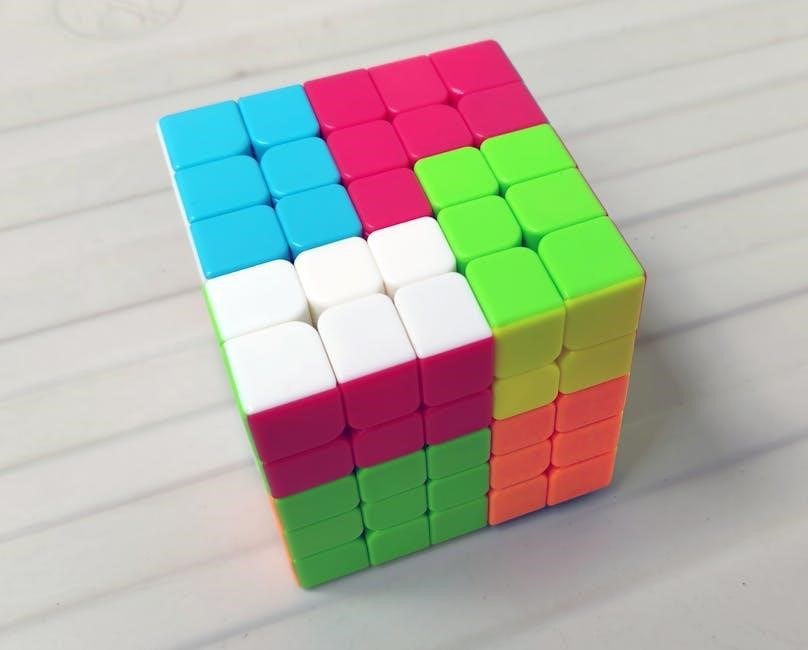
Step-by-Step Solving Process
Solve the first layer by aligning corners, then orient the last layer’s corners. Finally, permute the last layer to complete the cube using simple algorithms.
4.1 Step 1: Solving the First Layer
Solving the first layer is the foundation of the 2×2 Rubik’s Cube. Start by choosing a color to begin with, such as white or yellow, and focus on aligning the corners. Hold the cube in a way that allows easy access to all faces. Use simple algorithms to insert corner pieces into their correct positions. Match the colors of the corners with the centerpieces of the first layer. This step is straightforward and sets the stage for the remaining layers. Once the first layer is solved, you’ll have a clear visual guide for the next steps. Remember to keep the first layer facing you as you progress to maintain consistency. This step is simple but crucial for a smooth solving process.
4.2 Step 2: Solving the Second Layer
After completing the first layer, focus on solving the second layer by aligning the remaining corners. Turn the cube so the solved first layer is on the bottom. Use algorithms to move the top layer’s corners into their correct positions. Match the colors of the corners with the corresponding centerpieces of the second layer. Ensure each corner is placed without disturbing the first layer. If a corner is in the wrong position, use simple moves like R, L, or D to adjust it. Repeat this process until all corners in the second layer are correctly aligned. This step requires patience and attention to detail to ensure the cube is fully solved. Once the second layer is complete, proceed to orienting the last layer for the final touches.
4.3 Step 3: Orienting the Last Layer
Orienting the last layer involves ensuring all stickers on the top face of the cube are facing upwards. Hold the cube with the solved second layer on the bottom. If any stickers on the top layer are misaligned, perform the sequence R, L, or D moves to correct their orientation. Focus on one corner at a time, turning the top layer until its yellow or white sticker is on top. Repeat the process for each corner, ensuring not to disrupt the already solved layers. Once all top stickers are oriented correctly, the cube is nearly solved. This step requires precision and careful execution to maintain the progress made in previous steps.
4.4 Step 4: Permuting the Last Layer
Permuting the last layer involves aligning the corner pieces to their correct positions relative to the solved first layer. Hold the cube with the solved layers on the bottom. Identify the top layer’s corner arrangement and apply the appropriate PLL (Permuting Last Layer) algorithm. Common cases include swapping two corners or cycling all four. Use specific move sequences like R, L, or D turns to cycle the corners without disturbing the solved layers. Once all corners match the bottom layer’s colors, the cube is solved. This step requires careful execution to maintain prior progress and achieve the final alignment.

Common Cases and Algorithms
The 2×2 Rubik’s Cube solving process involves recognizing common cases and applying specific algorithms. Corner cases include misaligned or swapped pieces, requiring algorithms like R, L, or D moves. The Ortega method and PLL (Permuting Last Layer) algorithms are essential for solving edge cases and final alignment. These algorithms, detailed in the PDF guide, help beginners master the cube efficiently.
5.1 Corner Cases and Solutions
Solving the 2×2 Rubik’s Cube often involves addressing corner cases, where pieces are misaligned or swapped. Common issues include corners being in the wrong position or oriented incorrectly. The Ortega method, a popular solving technique, provides algorithms to resolve these cases. For example, if a corner is in the wrong position, algorithms like R, L, or D moves can be used to swap it with the correct one. Additionally, the PDF guide details specific sequences for orienting corners, such as flipping a corner’s color to match its target position. By mastering these algorithms, beginners can efficiently solve even the most challenging corner configurations, ensuring a smooth transition to the final solved state.
5.2 Edge Cases and Solutions
While the 2×2 Rubik’s Cube lacks traditional edge pieces, certain configurations can still pose challenges. One common edge case involves corners being misoriented or swapped. For instance, if two corners are flipped or exchanged, specific algorithms can restore their correct positions. The PDF guide outlines these scenarios, offering step-by-step solutions. Additionally, edge cases may arise during the final layer orientation, where corners might need to be realigned without disrupting already solved pieces. By mastering these advanced techniques, solvers can efficiently address even the most stubborn configurations, ensuring a perfectly solved cube. These strategies are crucial for improving speed and accuracy in competitive solving environments.
5.3 Algorithms for Each Case
The 2×2 Rubik’s Cube solution relies on specific algorithms tailored to address common cases. For corner orientation and permutation, algorithms such as R, L, U, D, F, and B moves are essential. These sequences help flip or swap corners to their correct positions. Advanced solvers use techniques like Ortega/Varasano or CLL (Corner Last Layer) methods, which involve shorter, more efficient algorithms. The PDF guide provides visual aids and step-by-step instructions for mastering these algorithms, ensuring solvers can handle all possible cases. By memorizing these sequences, cubers can significantly reduce solve times and improve accuracy, making the solving process more streamlined and efficient.
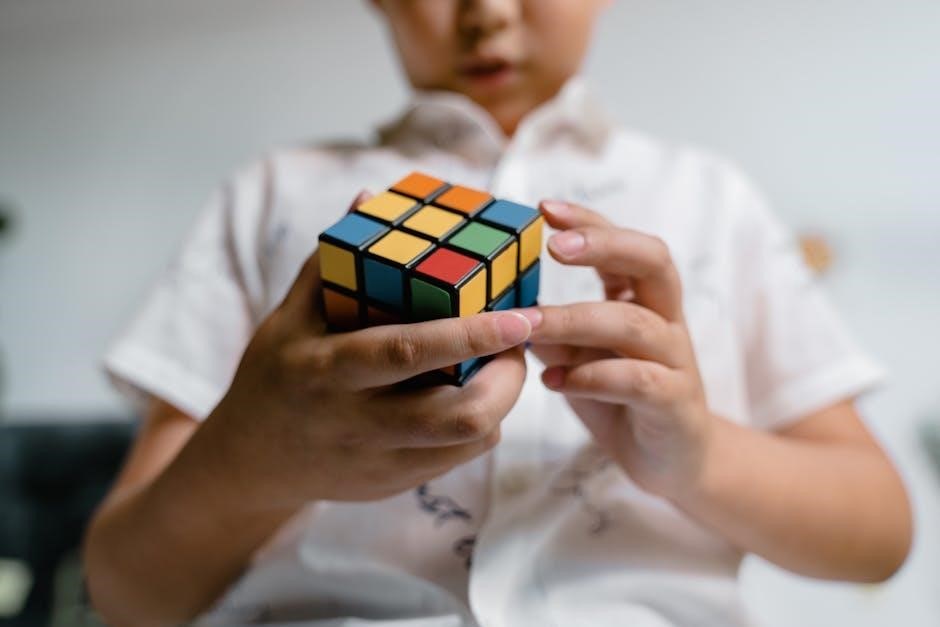
Advanced Solving Techniques
Mastering advanced techniques like speed solving, Ortega/Varasano, and CLL (Corners Last Layer) can significantly improve efficiency. These methods involve optimized algorithms and finger tricks to enhance performance.
6.1 Speed Solving Tips
To improve your speed solving skills on the 2×2 Rubik’s Cube, focus on consistent practice and mastering efficient algorithms. Start by optimizing your finger independence and dexterity, as this reduces hesitation during solves. Use the Ortega or CLL methods for faster execution. Keep the cube tension moderate to ensure smooth turns. Train your lookahead ability to anticipate the next move while executing the current one. Practice short drills regularly to build muscle memory. Stay relaxed and avoid over-gripping, as tension can slow you down; Finally, maintain your cube’s condition by lubricating it to ensure smooth rotations. Regular practice and these tips will significantly reduce your solve times.

6.2 Optimizing Your Solve Time
Optimizing your solve time on the 2×2 Rubik’s Cube requires a combination of practice, algorithm mastery, and efficient execution. Regular practice sessions help build muscle memory, reducing hesitation between moves. Focus on mastering fundamental algorithms like Ortega or CLL, as they provide the fastest paths to solving common cases. Maintain your cube by lubricating it to ensure smooth turns and faster rotations. Improve your grip technique to enable quick finger movements. Train your lookahead skills to anticipate upcoming moves while executing current ones. Avoid unnecessary moves by recognizing optimal solutions instantly. Consistency is key; short, focused practice sessions yield better results than occasional long ones. Stay relaxed and avoid over-gripping, as tension slows down your solving. By combining these strategies, you can significantly reduce your solve times and enhance your speedcubing performance.
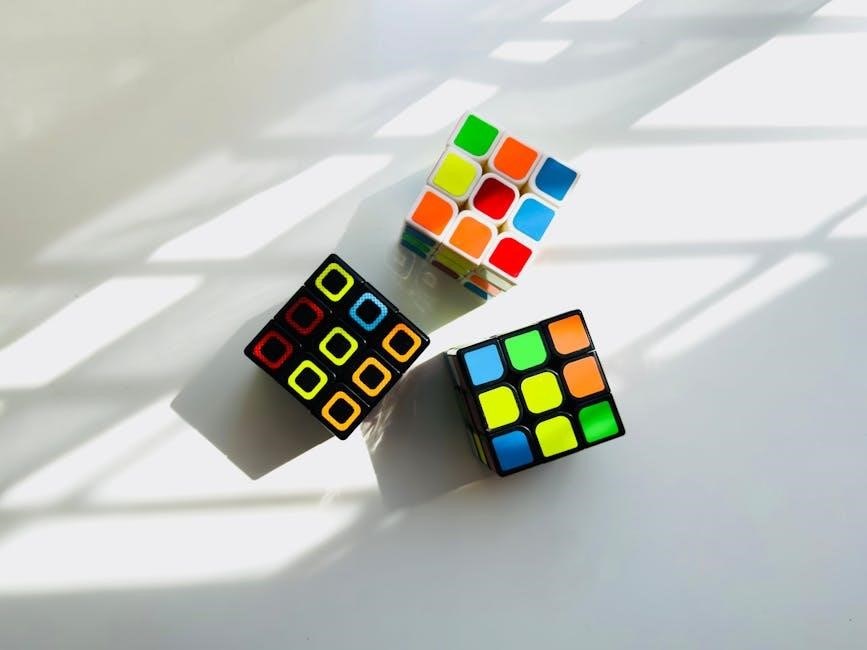
Frequently Asked Questions
Q: What is the best method for solving the 2×2 cube? A: The Ortega/Varasano method is highly recommended, offering a straightforward approach for beginners.
Q: How do I fix a single corner? A: Use specific algorithms to orient and permute the last layer without disturbing solved pieces.
Q: Why does the cube get messy after solving the first layer? A: This is normal; focus on completing the first layer before addressing the second.
Q: How can I improve my speed? A: Practice regularly, master algorithms, and refine your technique to minimize unnecessary moves.
7.1 Common Mistakes to Avoid
When solving the 2×2 Rubik’s Cube, several common mistakes can hinder progress. First, many beginners fail to orient corners correctly, leading to misaligned colors. This often occurs when rushing through moves without ensuring each piece is properly seated. Second, some solvers neglect to follow established algorithms, instead relying on random moves that complicate the cube’s state. Another mistake is not maintaining a consistent reference face, causing confusion during the solving process. Additionally, improper handling of the last layer can disrupt previously solved pieces. Lastly, insufficient practice and impatience are common pitfalls. To avoid these errors, focus on methodical moves, use recommended algorithms, and regularly check the cube’s orientation. Always practice consistently to build muscle memory and problem-solving skills.
7.2 Troubleshooting Tips

When encountering difficulties while solving the 2×2 Rubik’s Cube, there are several troubleshooting strategies to employ. If corners consistently misalign, revisit the algorithms for orienting and permuting the last layer. Double-checking each move’s execution ensures accuracy. Another common issue is forgetting specific algorithms, which can be resolved by practicing regularly or referring to the guide. Additionally, if the cube feels stuck or pieces are not moving smoothly, ensure proper lubrication and avoid excessive force. For solvers struggling with case recognition, focus on identifying patterns and practice solving from various starting points. Lastly, maintaining a consistent reference face can help prevent confusion. By addressing these challenges systematically, solvers can overcome obstacles and improve their skills effectively.
Mastering the 2×2 Rubik’s Cube is an achievable goal with dedication and practice. By following the step-by-step guide and troubleshooting common issues, you can solve the cube efficiently. Remember, patience and consistent practice are key to improving your solving skills. Download the PDF guide to enhance your learning experience and enjoy the satisfaction of solving this iconic puzzle!
8.1 Summary of the Solving Process
The 2×2 Rubik’s Cube solving process is straightforward and can be broken down into a few key steps. Start by solving the first layer, focusing on aligning the corners with their corresponding colors. Once the first layer is complete, move on to orienting the last layer, ensuring all remaining corners are correctly positioned and oriented. Finally, use specific algorithms to permute and solve the last layer, addressing any remaining misalignments. Understanding basic notation and common cases is essential for efficiently solving the cube. With practice, you’ll master these steps and improve your solving speed and accuracy. Refer to the PDF guide for detailed algorithms and troubleshooting tips to refine your skills.
8.2 Encouragement to Practice
Mastering the 2×2 Rubik’s Cube requires patience and consistent practice. While it may seem challenging at first, each solved layer brings a sense of accomplishment. Start with short practice sessions, focusing on one step at a time, and gradually increase your speed and efficiency. Celebrate small victories, like solving a single corner or completing a layer without errors. The more you practice, the more intuitive the algorithms will become. Don’t be discouraged by setbacks—every mistake is an opportunity to learn and improve. With dedication, you’ll soon solve the cube effortlessly. Keep practicing, and you’ll unlock the full potential of this puzzle, gaining confidence and problem-solving skills that extend beyond cubing.
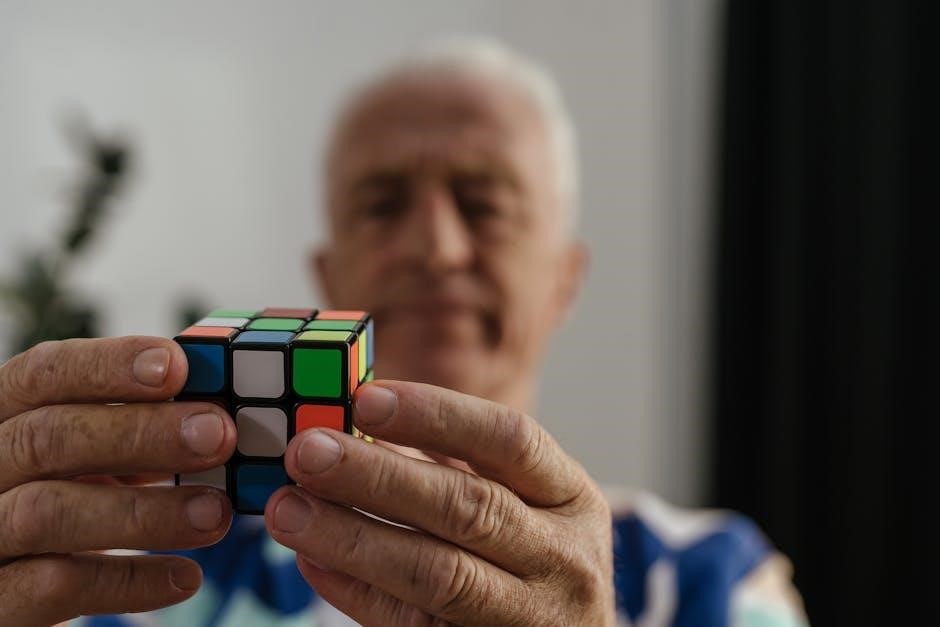
Downloading the PDF Guide
Download the free 2×2 Rubik’s Cube PDF Guide for step-by-step instructions, algorithms, and solving methods. Perfect for beginners, it provides an easy-to-follow roadmap to mastering the cube.
9.1 Where to Find the PDF Guide
The 2×2 Rubik’s Cube Solution Guide is widely available online. You can download it for free from platforms like Scribd or speedcube.com.au. Look for titles such as “Rubiks 2×2 Solution Guide” or “How to Solve a 2×2 Cube.” These guides are often shared as PDF files, making them easy to access and print. Visit the official Rubik’s Cube websites or trusted cubing communities for reliable downloads. Ensure you select guides from reputable sources to avoid incomplete or incorrect information. Once downloaded, you can use the guide alongside online tutorials for a comprehensive learning experience. This resource is essential for mastering the 2×2 cube efficiently.
9.2 How to Use the PDF Guide Effectively
To make the most of the 2×2 Rubik’s Cube PDF guide, start by printing it or saving it to your device for easy access. Begin with the introductory pages to understand basic cube notation and terminology. Follow the step-by-step solving process outlined in the guide, practicing each algorithm as you go. Regular practice is key to mastering the cube. Use the guide to identify and solve common cases, such as corner misorientation or incorrect permutations. Pay attention to the algorithms provided for each scenario, as they are essential for efficiently solving the cube. By combining the guide with hands-on practice, you’ll quickly improve your solving skills and speed. Refer back to the guide whenever you encounter challenges or need to refine your technique.
